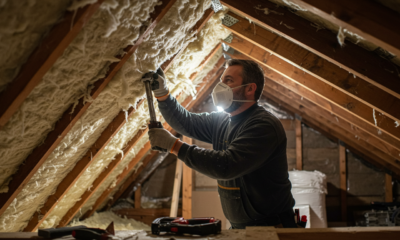

Environment
How To Have Eco-Friendly Sleep Night After Night
There are a lot of people making great eco-friendly decisions in their daily lives these days. From food choices to the types of cars we drive, eco-friendly options are mainly available. However, it’s still very surprising to find that most eco-friendly decisions don’t enter the bedroom. Sure, the furniture in your bedroom may be in support of the eco cause, but what about the mattress and bedding you use?
This is certainly no fault of anyone. Mattresses for instance are usually an afterthought when it comes to making eco-friendly decisions. And it could also be a pocketbook decision as well, since most mattresses are pretty expensive.
Today there are a lot of great eco-friendly options for people looking to make a difference in the bedroom. And having quality products that also support your personal views make it a win-win for sure. You may know the feeling of sleeping in a crater, or waking up sweating at night.
Eco-minded mattresses and bedding can change all that. For example, organic cotton and wool mattresses can provide the comfort you need to have the perfect night’s sleep. Let’s take a closer look at how you can sleep like a baby while staying eco-friendly in the bedroom.
Let’s Begin With Your Mattress
The mattress you lay on every night is the best place to start. Your mattress is the most important aspect of great sleep, and the centerpiece of your bedroom. Unfortunately, mattresses are pretty much unregulated, so you need to know what to watch for when considering eco-friendly mattress options.
There Are Chemicals In Mainstream Mattresses
Chemicals are in pretty much every product available in the mainstream market. It is very challenging to find products that do not contain toxins, especially when it comes to mattresses. In most cases, you can smell the chemicals on a mattress that contains toxins, so when shopping around, give every mattress a sniff test.
Why is this important? Mattresses can contain harmful chemicals that cause poor sleep and irritation to the skin, like volatile organic compounds (VOCs). For instance, on “organic” mattress company’s mattress was found to contain over 60 VOCs when analyzed in a lab. This is the issue, since most mattresses go unregulated. Choose mattresses that contain organic materials, but always go for the eco-friendly smell test to ensure you are not sleeping on a toxic bed.
Ask The Right Eco-Friendly Questions
When you begin your hunt for an eco-friendly mattress and start visiting mattress stores you’ve researched online, you will want to know the right questions to ask. Just because a mattress is labeled “green” or “natural” doesn’t make it so. In fact, mattress manufacturers may simply have a few green or natural practices in place during manufacturing. The entire mattress itself isn’t necessarily eco-friendly.
Once you’re aware of that, ask the sales people at the store what makes a specific mattress eco-friendly. You can ask:
- Why is the mattress labeled “eco” or green?
- What are the materials in the mattress?
- How is the mattress made?
- What aspects of the production make it green?
- Where is it made (ethical buying decisions)?
Once you find a mattress that satisfies your questions, you can make an informed decision about the “green” status. This allows you to make a purchase you feel good about. It can also allow you to not overspend on a mattress that is labeled “eco” and expensive, but is really no different than any other toxic mattress.
Choosing Eco-Friendly Bedding
Once you have found an affordable eco-friendly mattress you feel good about, it’s time to choose the right Earth-conscious bedding. Bedding can be the worst when it comes to toxins, since wrinkle-free and shine is so popular. The good news is that you can choose green bedding and even sleep better than using the toxic alternatives. Here are three eco-bedding options:
- Cotton bedding. Cotton is a great choice, so long as it’s organic cotton. Organic cotton does not contribute to the chemical production of regular cotton. The only downside to organic cotton bedding is wrinkles. But it’s certainly a small price to pay for doing your part. Cotton is soft and more breathable than other materials though, ensuring you get a great night’s sleep.
- Wool bedding. The material wool is great for eco-friendly people. It delivers warm and cool sleep, is fluffy, and it keeps dust mites off your bed. Most mainstream market wool bedding comes from overseas, so if you can choose a local option, you can cut out the transportation pollution.
- Bamboo bedding. Bamboo bedding is smooth and soft, serving up great eco-friendly sleep. Making bamboo linen does involve some chemicals, but truly green companies will ensure all chemicals are washed out of the material and recycled.
In Conclusion . . .
Getting an eco-friendly sleep night after night is certainly not unattainable. It takes a bit of due diligence to find the right mattress and bedding, but definitely worthwhile. The aim is to get the greenest option that fits your budget, and always think about the ethical aspects of the production too. Are you ready to make your bedroom Earth-friendly?


 Environment10 months ago
Environment10 months agoAre Polymer Banknotes: an Eco-Friendly Trend or a Groundswell?

 Environment11 months ago
Environment11 months agoEco-Friendly Home Improvements: Top 7 Upgrades for 2025

 Features9 months ago
Features9 months agoEco-Friendly Cryptocurrencies: Sustainable Investment Choices

 Features10 months ago
Features10 months agoEco-Friendly Crypto Traders Must Find the Right Exchange



























